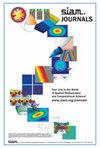离散形态神经网络
IF 2.3
3区 数学
Q3 COMPUTER SCIENCE, ARTIFICIAL INTELLIGENCE
引用次数: 0
摘要
SIAM 影像科学期刊》第 17 卷第 3 期第 1650-1689 页,2024 年 9 月。 摘要:设计二值图像算子的经典方法是数学形态学(MM)。我们提出了用于二值图像分析的离散形态神经网络(DMNN)来表示 W 运算符,并通过机器学习对其进行估计。DMNN 体系结构由形态计算图表示,其设计与形态算子的经典启发式设计类似,设计者应根据先验信息和理论知识将一组 MM 算子和布尔运算结合起来。然后,一旦结构固定下来,我们就不需要手工调整其参数(即结构元素或最大区间),而是根据通常的机器学习方法,基于输入和输出图像样本,提出一种网格下降算法(LDA)来训练这些参数。我们还提出了一种随机版本的 LDA,它效率更高、可扩展,而且在实际问题中误差很小。根据目标算子的预期属性(即先验信息),DMNN 所代表的类可以是非常通用的,也可以是专门化的,算子类的代数属性所表达的语义是相对于其他方法的一种差异。本文的主要贡献在于合并了设计形态运算符的两种主要范式:经典的启发式设计和通过机器学习的自动设计。作为概念验证,我们将 DMNN 应用于识别有噪声的数字边界,并讨论了未来研究的许多课题。本文章由计算机程序翻译,如有差异,请以英文原文为准。
Discrete Morphological Neural Networks
SIAM Journal on Imaging Sciences, Volume 17, Issue 3, Page 1650-1689, September 2024.
Abstract.A classical approach to designing binary image operators is mathematical morphology (MM). We propose the Discrete Morphological Neural Networks (DMNN) for binary image analysis to represent W-operators and estimate them via machine learning. A DMNN architecture, which is represented by a morphological computational graph, is designed as in the classical heuristic design of morphological operators, in which the designer should combine a set of MM operators and Boolean operations based on prior information and theoretical knowledge. Then, once the architecture is fixed, instead of adjusting its parameters (i.e., structuring elements or maximal intervals) by hand, we propose a lattice descent algorithm (LDA) to train these parameters based on a sample of input and output images under the usual machine learning approach. We also propose a stochastic version of the LDA that is more efficient, is scalable, and can obtain small error in practical problems. The class represented by a DMNN can be quite general or specialized according to expected properties of the target operator, i.e., prior information, and the semantic expressed by algebraic properties of classes of operators is a differential relative to other methods. The main contribution of this paper is the merger of the two main paradigms for designing morphological operators: classical heuristic design and automatic design via machine learning. As a proof-of-concept, we apply the DMNN to recognize the boundary of digits with noise, and we discuss many topics for future research.
Abstract.A classical approach to designing binary image operators is mathematical morphology (MM). We propose the Discrete Morphological Neural Networks (DMNN) for binary image analysis to represent W-operators and estimate them via machine learning. A DMNN architecture, which is represented by a morphological computational graph, is designed as in the classical heuristic design of morphological operators, in which the designer should combine a set of MM operators and Boolean operations based on prior information and theoretical knowledge. Then, once the architecture is fixed, instead of adjusting its parameters (i.e., structuring elements or maximal intervals) by hand, we propose a lattice descent algorithm (LDA) to train these parameters based on a sample of input and output images under the usual machine learning approach. We also propose a stochastic version of the LDA that is more efficient, is scalable, and can obtain small error in practical problems. The class represented by a DMNN can be quite general or specialized according to expected properties of the target operator, i.e., prior information, and the semantic expressed by algebraic properties of classes of operators is a differential relative to other methods. The main contribution of this paper is the merger of the two main paradigms for designing morphological operators: classical heuristic design and automatic design via machine learning. As a proof-of-concept, we apply the DMNN to recognize the boundary of digits with noise, and we discuss many topics for future research.
求助全文
通过发布文献求助,成功后即可免费获取论文全文。
去求助
来源期刊

SIAM Journal on Imaging Sciences
COMPUTER SCIENCE, ARTIFICIAL INTELLIGENCE-COMPUTER SCIENCE, SOFTWARE ENGINEERING
CiteScore
3.80
自引率
4.80%
发文量
58
审稿时长
>12 weeks
期刊介绍:
SIAM Journal on Imaging Sciences (SIIMS) covers all areas of imaging sciences, broadly interpreted. It includes image formation, image processing, image analysis, image interpretation and understanding, imaging-related machine learning, and inverse problems in imaging; leading to applications to diverse areas in science, medicine, engineering, and other fields. The journal’s scope is meant to be broad enough to include areas now organized under the terms image processing, image analysis, computer graphics, computer vision, visual machine learning, and visualization. Formal approaches, at the level of mathematics and/or computations, as well as state-of-the-art practical results, are expected from manuscripts published in SIIMS. SIIMS is mathematically and computationally based, and offers a unique forum to highlight the commonality of methodology, models, and algorithms among diverse application areas of imaging sciences. SIIMS provides a broad authoritative source for fundamental results in imaging sciences, with a unique combination of mathematics and applications.
SIIMS covers a broad range of areas, including but not limited to image formation, image processing, image analysis, computer graphics, computer vision, visualization, image understanding, pattern analysis, machine intelligence, remote sensing, geoscience, signal processing, medical and biomedical imaging, and seismic imaging. The fundamental mathematical theories addressing imaging problems covered by SIIMS include, but are not limited to, harmonic analysis, partial differential equations, differential geometry, numerical analysis, information theory, learning, optimization, statistics, and probability. Research papers that innovate both in the fundamentals and in the applications are especially welcome. SIIMS focuses on conceptually new ideas, methods, and fundamentals as applied to all aspects of imaging sciences.
 求助内容:
求助内容: 应助结果提醒方式:
应助结果提醒方式:


